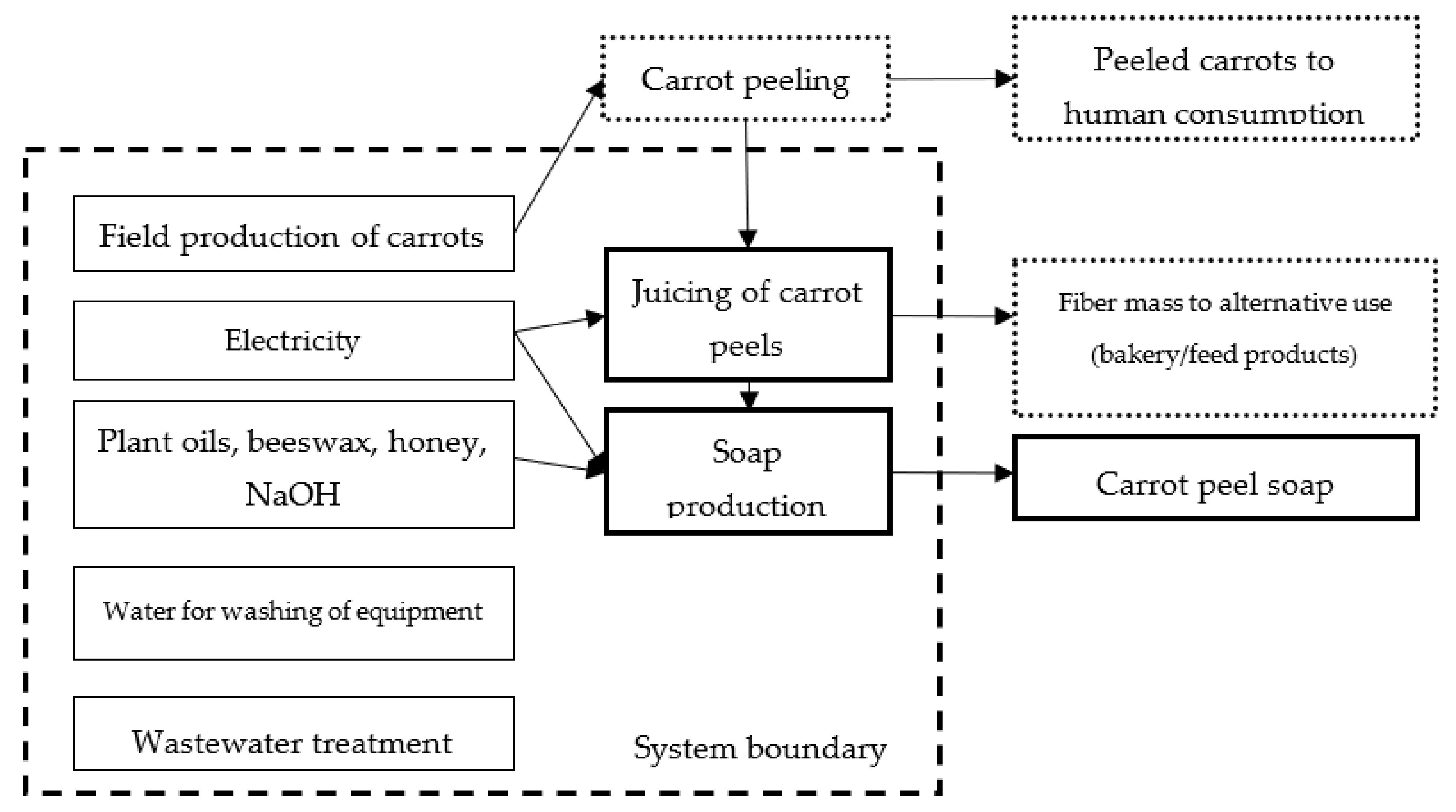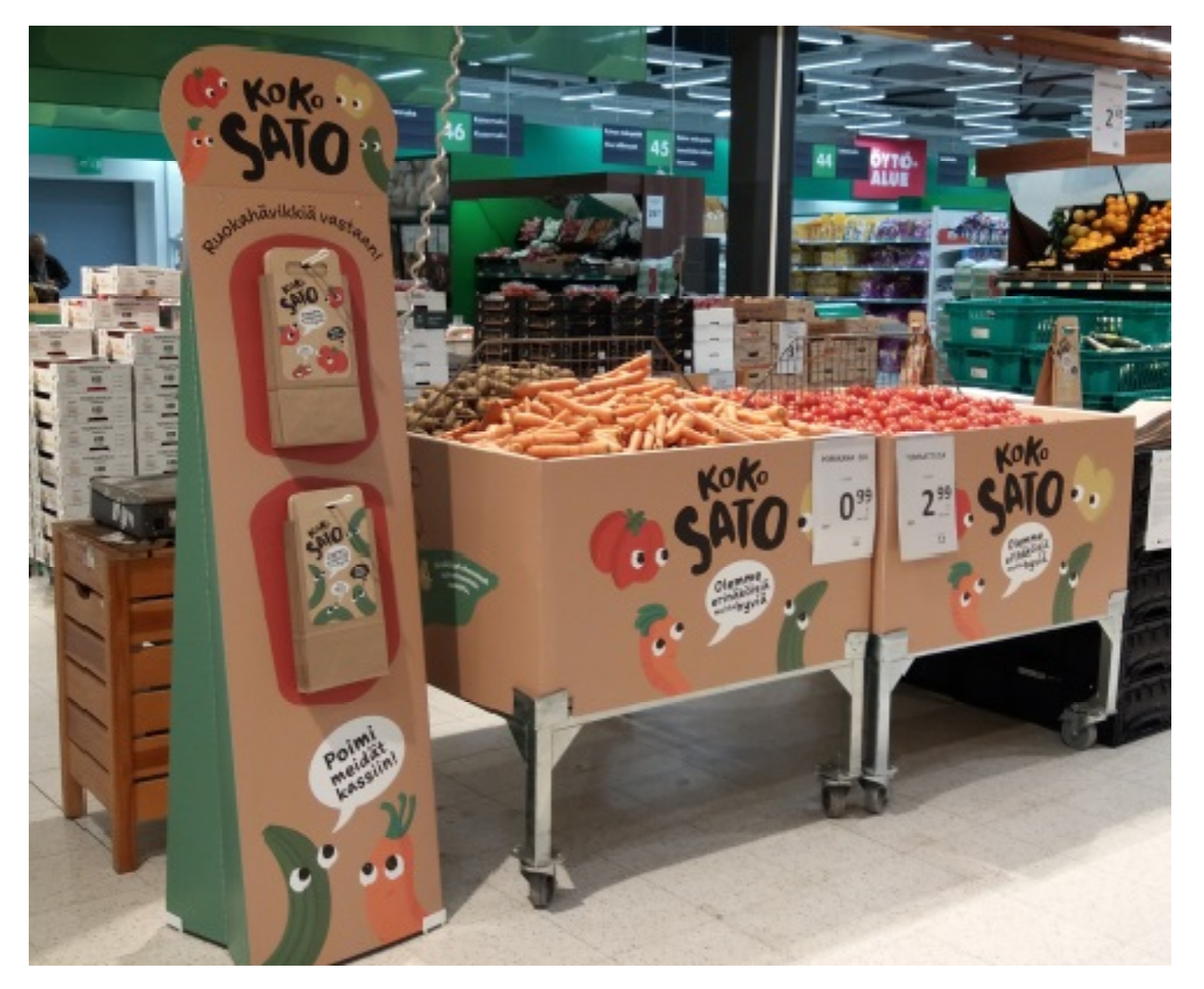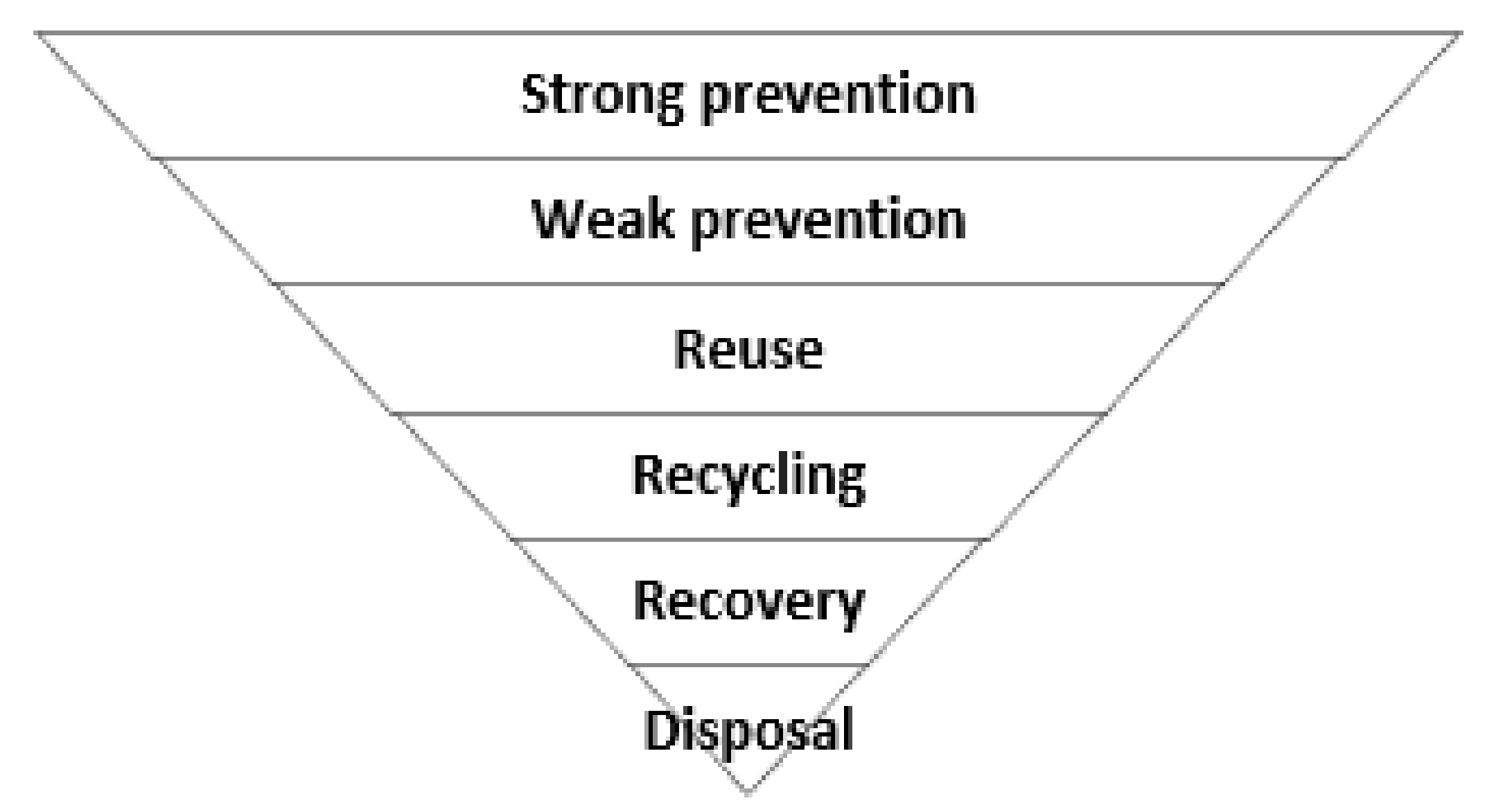What to Do with Food Waste? A Holistic Feasibility Framework to Evaluate Different Solutions
Abstract
1. Introduction
2. Materials and Methods
2.1. Food Waste Reduction Framework
2.2. Edible Food Waste Reduction Potential and Scalability
2.3. Level at Waste Hierarchy
2.4. Climate Impact Reduction Potential
2.5. Economic Impact
2.6. Social Impact
2.7. Carrot as a Case Product
3. Results
3.1. Scalability and Edible Food Waste Reduction Potential
3.1.1. Artisan Bar Soap
3.1.2. Retail Selling of 2nd Class Carrots
3.2. Level at Waste Hierarchy
3.2.1. Artisan Bar Soap
3.2.2. Retail Selling of 2nd Class Carrots
3.3. Climate Impact Reduction Potential
3.3.1. Artisan Bar Soap
3.3.2. Retail Selling of 2nd Class Carrots
3.4. Economic Impact
3.4.1. Artisan Bar Soap
3.4.2. Retail Selling of 2nd Class Carrots
3.5. Social Impact
3.5.1. Artisan Bar Soap
3.5.2. Retail Selling of 2nd Class Carrots
3.6. Framework to Evaluate Food Waste Reduction Solutions
4. Discussion
4.1. Artisan Bar Soap
4.2. Retail Selling of 2nd Class Carrots
5. Conclusions
Author Contributions
Funding
Acknowledgments
Conflicts of Interest
Appendix A
Appendix A.1. Calculation Details of Climate Impact Reduction Potential and Economic Impact
Appendix A.1.1. Calculation Details of Climate Impact Reduction Potential
Appendix A.1.2. Artisan Bar Soap

| Consumption/kg Soap | Cost, EUR/kg Soap | Source of Cost Estimate | |
|---|---|---|---|
| Input Materials, kg | |||
| Carrot peels | 0.476 | 0.01 | |
| Linseed oil | 0.162 | 3.17 | https://www.karkkainen.com/verkkokauppa/pellavansiemenoljy-500-ml, accessed on 13 June 2019 |
| Turnip rape oil | 0.599 | 1.52 | https://www.k-ruoka.fi/kauppa/tuote/pirkka-rypsioljy-900ml-6410405191434, accessed on 13 June 2019 |
| Beeswax | 0.049 | 0.85 | https://www.lahtisenvahavalimo.fi/mehilaisvaha-kosmetiikka.html, accessed on 13 June 2019 |
| Honey | 0.014 | 0.15 | https://www.mehilaishoitajat.fi/?x118281=5599710, accessed on 13 June 2019 |
| NaOH | 0.099 | 0.52 | https://www.lahtisenvahavalimo.fi/saippuatarvikkeet/lipea/lipearae-10–8-kg-toimitus-vain-matkahuollossa.html, accessed on 13 June 2019 |
| Water | 4.762 | 0.01 | https://julkaisu.hsy.fi/vesihuollon-hinnasto-ja-palvelumaksuhinnasto-2019.html, accessed on 13 June 2019 |
| Packing material (paper bags from recycled paper), kg | 0.002 | 0.80 | https://www.napakka.fi/aromipussi-eko, accessed on 13 June 2019 |
| Electricity, kWh | |||
| Juicing | 0.033 | ||
| Wax melting | 0.048 | ||
| Mixing | 0.014 | ||
| Washing machine | 0.476 | ||
| Total electricity | 0.571 | 0.08 | https://www.sahkonhinta.fi/summariesandgraphs, accessed on 13 June 2019 |

Appendix A.1.3. Retail Selling of 2nd Class Carrots


Appendix A.2. Calculation Details of Economic Impact
Appendix A.2.1. Artisan Bar Soap
| Artisan Soaps | Price EUR/kg | Marketing Arguments | Source |
|---|---|---|---|
| Carrot vitamin soap | 69 |
| https://www.life.fi/Nurme-Carrot-Vitamin-Soap, accessed on 12 June 2019 |
| Shower soap bars | 75 |
| https://www.luonteva.fi/tuotteet/luonteva-suihkusaippuat/, accessed on 12 June 2019 |
| Face soap containing birch leaves and seaweed | 127.14 |
| https://www.ruohonjuuri.fi/kasvosaippua-koivu-merileva-madara-4751009822082, accessed on 12 June 2019 |
| Variable Costs per Month | EUR/9 kg Soap |
|---|---|
| Car use | 60 |
| Raw materials (from Table A1) | 64 |
| Marketing and communication | 60 |
| Office costs (use of phone and internet and other office equipment) | 80 |
| Material waste related to product development | 20 |
| Maintenance of own webstore | 29 |
| Total variable cost | 313 |
| Sales revenue | 810 |
| Profit margin | 497 |
Appendix A.2.2. Retail Selling of 2nd Class Carrots
References
- UN. Goal 12: Ensure Sustainable Consumption and Production Patterns. United Nations. 2018. Available online: http://www.un.org/sustainabledevelopment/sustainable-consumption-production/ (accessed on 11 December 2018).
- EC. EU Actions against Food Waste. European Commission. 2018. Available online: https://ec.europa.eu/food/safety/food_waste/eu_actions_en (accessed on 6 June 2019).
- Gustavsson, J.; Cederberg, C.; Sonesson, U.; van Otterdijk, R.; Meybeck, A. Global Food Losses and Food Waste: Extent, Causes and Prevention; FAO: Rome, Italy, 2011; Available online: http://www.fao.org/docrep/014/mb060e/mb060e00.pdf (accessed on 12 June 2019).
- Hartikainen, H.; Riipi, I.; Katajajuuri, J.-M.; Silvennoinen, K. From measurement to management: Food waste in the Finnish food chain. In Food Waste Management: Solving the Wicked Problem; Palgrave Macmillan: Cham, Switzerland, 2020. [Google Scholar]
- Hartikainen, H.; Mogensen, L.; Svanes, E.; Franke, U. Food waste quantification in primary production—The Nordic countries as a case study. Waste Manag. 2018, 71, 502–511. [Google Scholar] [PubMed]
- EC. Directive 2008/98/EC of the European Parliament and the Council on waste and repealing certain documents. Off. J. Eur. Union 2008, 51, 3–30. [Google Scholar]
- De Brito Nogueira, T.B.; da Silva, T.P.M.; de Araújo Luiz, D.; de Andrade, C.J.; de Andrade, L.M.; Ferreira, M.S.L.; Fai, A.E.C. Fruits and vegetable-processing waste: A case study in two markets at Rio de Janeiro, RJ, Brazil. Environ. Sci. Pollut. Res. 2020, 2020, 18530–18540. [Google Scholar]
- Parfitt, J.; Barthel, M.; Macnaughton, S. Food waste within food supply chains: Quantification and potential for change to 2050. Philos. Trans. R. Soc. B Biol. Sci. 2010, 365, 3065–3081. [Google Scholar] [CrossRef] [PubMed]
- Hodges, R.J.; Buzby, J.C.; Bennett, B. Postharvest losses and waste in developed and less developed countries: Opportunities to improve resource use. J. Agric. Sci. 2011, 149, 37–45. [Google Scholar] [CrossRef]
- Imbert, E. Food waste valorization options: Opportunities from the bioeconomy. Open Agric. 2017, 2, 195–204. [Google Scholar]
- Morone, P.; Papendiek, F.; Tartiu, V.E. (Eds.) Food Waste Reduction and Valorisation; Springer: Berlin/Heidelberg, Germany, 2017. [Google Scholar]
- Pawar, P.R.; Rao, P.; Prakash, G.; Lali, A.M. Organic waste streams as feedstock for the production of high volume-low value products. Environ. Sci. Pollut. Res. 2020, 28, 11904–11914. [Google Scholar] [CrossRef]
- Smol, M.; Kulczycka, J.; Avdiushchenko, A. Circular economy indicators in relation to eco-innovation in European regions. Clean Technol. Environ. Policy 2017, 19, 669–678. [Google Scholar] [CrossRef]
- EC. Circular Economy Indicators. Eco-Innovation. European Commission. 2019. Available online: https://ec.europa.eu/environment/ecoap/indicators/circular-economy-indicators_en (accessed on 16 December 2019).
- Geng, L.; Xing, J.; Kong, Z.; Geng, L.; Gao, H. Study on Evaluating the Sustainability of Innovative Products. Adv. Mater. Sci. Eng. 2019, 2019, 8493034. [Google Scholar] [CrossRef]
- Hansen, E.G.; Grosse-Dunker, F.; Reichwald, R. Sustainability innovation cube—A framework to evaluate sustainability-oriented innovations. Int. J. Innov. Manag. 2009, 13, 683–713. [Google Scholar] [CrossRef]
- Morrissey, A.J.; Browne, J. Waste management models and their application to sustainable waste management. Waste Manag. 2004, 24, 297–308. [Google Scholar] [CrossRef]
- Milutinović, B.; Stefanović, G.; Dassisti, M.; Marković, D.; Vučković, G. Multi-criteria analysis as a tool for sustainability assessment of a waste management model. Energy 2014, 74, 190–201. [Google Scholar] [CrossRef]
- Iacovidou, E.; Voulvoulis, N. A multi-criteria sustainability assessment framework: Development and application in comparing two food waste management options using a UK region as a case study. Environ. Sci. Pollut. Res. 2018, 25, 35821–35834. [Google Scholar] [CrossRef]
- Mourad, M. Recycling, recovering and preventing “food waste”: Competing solutions for food systems sustainability in the United States and France. J. Clean. Prod. 2016, 126, 461–477. [Google Scholar] [CrossRef]
- Mattsson, L.; Williams, H.; Berghel, J. Waste of fresh fruit and vegetables at retailers in Sweden–Measuring and calculation of mass, economic cost and climate impact. Resour. Conserv. Recycl. 2018, 130, 118–126. [Google Scholar] [CrossRef]
- De Menna, F.; Davis, J.; Östergren, K.; Unger, N.; Loubiere, M.; Vittuari, M. A combined framework for the life cycle assessment and costing of food waste prevention and valorization: An application to school canteens. Agric. Food Econ. 2020, 8, 2. [Google Scholar] [CrossRef]
- Goossens, Y.; Wegner, A.; Schmidt, T. Sustainability assessment of food waste prevention measures: Review of existing evaluation practices. Front. Sustain. Food Syst. 2019, 3, 90. [Google Scholar] [CrossRef]
- De Laurentiis, V.; Caldeira, C.; Sala, S. No time to waste: Assessing the performance of food waste prevention actions. Resour. Conserv. Recycl. 2020, 161, 104946. [Google Scholar] [CrossRef]
- Luke Horticultural Statistics. 2018. Available online: http://stat.luke.fi/en/horticultural-statistics (accessed on 11 December 2018).
- Hartikainen, H.; Svanes, E.; Franke, U.; Mogensen, L.; Andersson, S.; Bond, R.; Burman, C.; Einarsson, E.; Eklöf, P.; Joensuu, K.; et al. Food losses and waste in primary production. Case studies on carrots, onions, peas, cereals and farmed fish. Nord. Couns. Minist. TemaNord 2016, 2016, 557. [Google Scholar]
- Karotia, Oy. 2018. Available online: http://karotia.fi/in-english/ (accessed on 11 December 2018).
- EC. Commission Regulation (EC) No 1221/2008 of 5 December 2008 amending Regulation (EC) No 1580/2007 laying down implementing rules of Council Regulations (EC) No 2200/96, (EC) No 2201/96 and (EC) No 1182/2007 in the fruit and vegetable sector as regards marketing standards. Off. J. Eur. Union 2007, 2008, L336. [Google Scholar]
- Mattsson, K. Vi Slänger Frukt Och Grönsaker i Onödan-Varför? Jordbruksverket: Jönköping, Sweden, 2014; Rapport 5/2014. 2014. Available online: https://www.jordbruksverket.se/download/18.37e9ac46144f41921cd2a1e/1395998034568/Rapport_Vi+sl%C3%A4nger+frukt+och+gr%C3%B6nsaker+i+on%C3%B6dan_140328.pdf (accessed on 12 June 2019).
- De Hooge, I.E.; van Dulm, E.; van Trijp, H.C.M. Cosmetic specifications in the food waste issue: Supply chain considerations and practices concerning suboptimal food products. J. Clean. Prod 2018, 183, 698–709. [Google Scholar] [CrossRef]
- Hartikainen, H.; Svanes, E.; Franke, U.; Mogensen, L. Available online: https://norden.diva-portal.org/smash/record.jsf?pid=diva2%3A1076202&dswid=6818 (accessed on 12 June 2019).
- Luque, R.; Clark, J.H. Valorisation of Food Residues: Waste to Wealth Using Green Chemical Technologies. Sustain. Chem. Process. 2013, 1, 10. [Google Scholar] [CrossRef]
- Topolansky Barbe, F.; Von Dewitz, P.; Gonzalez Triay, M. Understanding Consumer Behaviour to Develop Competitive Advantage: A Case Study Exploring the Attitudes of German Consumers towards Fruits with Cosmetic Flaws. Int. J. Acad. Res. Bus. Soc. Sci. 2017, 2017, 554–580. [Google Scholar]
- Van Giesen, R.I.; de Hooge, I.E. Too ugly, but I love its shape: Reducing Food Waste of Suboptimal Products with Authenticity (and Sustainability) Positioning. Food Qual. Prefer. 2019, 75, 249–259. [Google Scholar] [CrossRef]
- Gerbens-Leenes, P.W.; Moll, H.C.; Uiterkamp, A.S. Design and development of a measuring method for environmental sustainability in food production systems. Ecol. Econ. 2003, 46, 231–248. [Google Scholar] [CrossRef]
- Roy, P.; Nei, D.; Orikasa, T.; Xu, Q.; Okadome, H.; Nakamura, N.; Shiina, T. A review of life cycle assessment (LCA) on some food products. J. Food Eng. 2009, 90, 1–10. [Google Scholar] [CrossRef]
- Bystrická, J.; Kavalcová, P.; Musilová, J.; Vollmannová, A.; Tomáš, T.Ó.T.H.; Lenková, M. Carrot (Daucus carota L. ssp. sativus (Hoffm.) Arcang.) as source of antioxidants. Acta Agric. Slov. 2015, 105, 303–311. [Google Scholar] [CrossRef]
- Secchi, M.; Castellani, V.; Collina, E.; Mirabella, N.; Sala, S. Assessing eco-innovations in green chemistry: Life Cycle Assessment (LCA) of a cosmetic product with a bio-based ingredient. J. Clean. Prod. 2016, 129, 269–281. [Google Scholar] [CrossRef]
- Ribeiro, I.; Sobral, P.; Peças, P.; Henriques, E. A sustainable business model to fight food waste. J. Clean. Prod. 2018, 177, 262–275. [Google Scholar] [CrossRef]
- Kasvistieto Oy. Average Producer Price from Years 2011–2017. 2018. Available online: http://kasvistieto.fi/vuosikeskihinnat/ (accessed on 11 December 2018).
- Orastava Aurinko Oy. Forage Carrot Price. 2018. Available online: https://www.porkkanaa.fi/porkkanat.html (accessed on 11 December 2018).
- Räsänen, K.; Saarinen, M.; Kurppa, S.; Silvenius, F.; Riipi, I.; Nousiainen, R.; Erälinna, L.; Mattinen, L.; Jaakkola, S.; Lento, S.; et al. Lähiruuan Ekologisten Vaikutusten Selvitys. MTT Raportti 145, Jokioinen. 2014. Available online: https://jukuri.luke.fi/bitstream/handle/10024/484465/mttraportti145.pdf?sequence=5 (accessed on 12 June 2019).
- Saarinen, M.; Sinkko, T.; Joensuu, K.; Silvenius, F.; Ratilainen, A. Ravitsemus ja Maaperävaikutukset Ruoan Elinkaariarvioinnissa: SustFoodChoice-Hankkeen Loppuraportti. MTT Raportti 146. 2014. Available online: https://jukuri.luke.fi/bitstream/handle/10024/482916/mttraportti146.pdf (accessed on 12 June 2019).
- Tenhunen, J.; Oinonen, J.; Seppälä, J. Vesihuollon Elinkaaritutkimus. Tampereen Vesilaitoksen Vaikutukset Ympäristöön. Suomen Ympäristö 434. 2000. Available online: https://helda.helsinki.fi/handle/10138/175821 (accessed on 12 June 2019).
- Technical Research Centre of Finland (VTT). Unit Emissions of Traffic. Lipasto-Database. 2018. Available online: http://lipasto.vtt.fi/yksikkopaastot/indexe.htm (accessed on 11 December 2018).
- Pöyry. Työkalut ja Mittarointi Vesilaitosten Ilmastomyönteiseen Toiminnan Kehittämiseen (Tools and Metering for Climate Friendly Development of Water Utilities). Pöyry, Vantaa, Finland. 2009. Report 67090263. Available online: https://www.yumpu.com/fi/document/view/34009370/vvy2009-26-3-netti (accessed on 12 June 2019).
- Myllymaa, T.; Moliis, K.; Tohka, A.; Rantanen, P.; Ollikainen, M.; Dahlbo, H. Jätteiden Kierrätyksen ja Polton Käsittelyketjujen Ympäristökuormitus ja Kustannukset. Suomen Ympäristökeskuksen Raportteja 28/2008. 2008. Available online: https://helda.helsinki.fi/handle/10138/39792 (accessed on 12 June 2019).
- Rahn, C.R.; Lillywhite, R.D. A study of the quality factors affecting the short-term decomposition of field vegetable residues. J. Sci. Food Agric. 2002, 82, 19–26. [Google Scholar] [CrossRef]
- Joensuu, K. Utilization of 2nd class fruits and vegetables. In Food Waste Not Want Not—Why Food Waste Is a Big Deal and How to Scale-Up Preventive Action; Simanovska, J., Billingham, C., Eds.; Foundation for European Progressive Studies: Brussels, Belgium, 2018; pp. 143–157. [Google Scholar]
- Kajalo, M. Porkkanan Viljelyn Tuotantokustannuslaskelmat: Varastoporkkanan Viljely Versus Varhaisporkkanan Viljely (Production Costs of Carrot Cultivation: Storage Carrot Cultivation Versus Early Carrot Cultivation). 2013. Available online: https://portal.mtt.fi/portal/page/portal/kasper/puutarha/vihannekset/porkkana/Porkkanan_talouslaskelmat/Taustatietoja%2Bp%C3%A4%C3%A4telmi%C3%A4varastoporkkanaversusvarhaisporkkana07.11.2013.pdf (accessed on 6 June 2019).
| Side Flow Utilisation Solution | Edible Food Waste Reduction Potential | Scalability | Level at the Waste Hierarchy | Climate Impact Reduction Potential | Economic Impact | Social Impact | Food Waste Solution-Score |
|---|---|---|---|---|---|---|---|
| Example 1 | + | + | 0 | 0 | - | - | 0 |
| Feasibility Indicator | Classification Criteria | Most Desirable (++) | Desirable (+) | Indifferent (0) | Not Desirable (-) |
|---|---|---|---|---|---|
| Edible food waste reduction potential | Reduction potential of edible food waste related to the current practice | 50–100% | 10–50% | 1–10% | <1% |
| Scalability | Utilisation potential of food waste related to the current practice | Highly scalable | Scalable | Weak scalability | Not scalable |
| Level at the waste hierarchy | End use of food waste | Strong prevention | Weak prevention and Reuse | Recycling and Recovery | Disposal |
| Climate impact reduction potential | Reduction potential of climate impact related to the current practice | 50–100% | 10–50% | 1–10% | <1% |
| Economic impact | Increase of profit margin related to the current practice | 50–100% | 10–50% | 1- 10% | <1% |
| Social impact | Acceptability compared to the current practice | Clearly more acceptable | Somewhat more acceptable | Equally acceptable | Less acceptable |
| Side Flow Utilisation Solution | Edible Food Waste Reduction Potential | Scalability | Level at the Waste Hierarchy | Climate Impact Reduction Potential | Economic Impact | Social Impact | Food Waste Solution-Score |
|---|---|---|---|---|---|---|---|
| Artisan bar soap | - | 0 | 0 | - | ++ | 0 | 0 |
| Retail selling of 2nd class carrots | ++ | ++ | ++ | 0 | + | + | ++ |
Publisher’s Note: MDPI stays neutral with regard to jurisdictional claims in published maps and institutional affiliations. |
© 2022 by the authors. Licensee MDPI, Basel, Switzerland. This article is an open access article distributed under the terms and conditions of the Creative Commons Attribution (CC BY) license (https://creativecommons.org/licenses/by/4.0/).
Share and Cite
Joensuu, K.; Harrison, E.; Hartikainen, H. What to Do with Food Waste? A Holistic Feasibility Framework to Evaluate Different Solutions. Sustainability 2022, 14, 13004. https://doi.org/10.3390/su142013004
Joensuu K, Harrison E, Hartikainen H. What to Do with Food Waste? A Holistic Feasibility Framework to Evaluate Different Solutions. Sustainability. 2022; 14(20):13004. https://doi.org/10.3390/su142013004
Chicago/Turabian StyleJoensuu, Katri, Eric Harrison, and Hanna Hartikainen. 2022. "What to Do with Food Waste? A Holistic Feasibility Framework to Evaluate Different Solutions" Sustainability 14, no. 20: 13004. https://doi.org/10.3390/su142013004
APA StyleJoensuu, K., Harrison, E., & Hartikainen, H. (2022). What to Do with Food Waste? A Holistic Feasibility Framework to Evaluate Different Solutions. Sustainability, 14(20), 13004. https://doi.org/10.3390/su142013004









